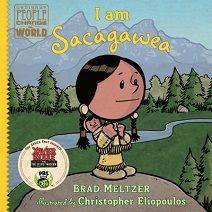Post by richardvasseur on Mar 11, 2021 20:50:52 GMT

Book title: I am Sacagawea
Author: Brad Meltzer
Illustrated by: Christopher Elipoulos
Biographical book in series: “Ordinary People Change the World” series.
Non-fiction
ISBN: 978-0-525-42853-4
Dial Books for Young Readers
38 pages
Text and illustrations copy wrote in 2017.
Reviewed by: Allen Klingelhoets
www.ordinarypeoplechangetheworld.com/
Sacagawea was native-American. She was born in 1789. This was during time when George Washington was just becoming President. She was a member of the Indian tribe Shoshoni. The family or tribe lived in area that is now called Idaho. The United States was so young that Idaho did not exist as a state yet in North America.
The biography talks about her very early history. I also learned how she got her name Sacagawea. When she was twelve years old her Shoshoni tribe got attacked by another tribe. They captured her and took her to other tribe grounds. I am not sure on exact location of new tribe. It was also told that her original name was not known. She was given to a French Canadian and she became his wife. War captures were treated like property – something that could be given away. She was only 14 when she got married. She soon became pregnant.
The story tells during winter time when she was still pregnant Meriwether Lewis and William Clark (explorers) came to the village needing an interpreter who could speak to other native, American tribes, like the Hidatsa. The mission was from President Thomas Jefferson. Jefferson had made purchase where he bought a huge section of North America from France. The deal was called ”The Louisiana Purchase”. The area of USA was unexplored. The goal was to examine the land, open trade relations with the Native Americans and find a safe path from where she lived to Pacific Ocean.
I thought very difficult time seeing when journey was about to start her baby was born. The baby was named by Lewis and Clark group “Pomp” after a Roman General. The baby was taken by Sacagawea on journey even though very dangerous.
The book tells how Sacagawea was able to use Indian instincts to recognize foods that explorers never knew existed. There was episode when storm caused medicines and supplies to be tipped off boat. The only person to stay calm was Sacagawea. Carefully balancing herself – with her infant strapped on her back – she was able to gather most of medicines and supplies.
I learned how she did job as interpreter, helping Lewis and Clark speak to other tribes. I even learned some of the Shoshoni words for words like tree is Soho’bi and the word for horse is Bungu. Conflicts happened constantly exploring The Louisiana Purchase. Lewis and Clark group were called “Corps of Discovery”.
The story tells trials and tribulations for group getting to Pacific Ocean. The image drawn by Christopher Eliopoulos of Sacagawea looking at Pacific Ocean with her baby strapped to her back had tremendous amount of emotional feeling. The journey to Pacific Ocean took over a year. Brad Meltzer made sure in text told through Sacagawea first person view that because she was Native American, she was not treated equal by explorers. That’s how it was back then.
That’s not how it should be. The key points were do not let people under estimate you. She was a girl, and expected to be weak, since she was young the explorers expected her to be inexperienced. That is not how it should be at all. Sacagawea husband who was also on “Corps of Discovery” mission was paid $ 533.30 and given 320 acres of land at end of expedition. As his wife, Sacagawea was paid nothing. That was not fair. The story ends with how things have changed in history due to Sacagawea. Without her knowledge the Lewis and Clark Expedition might never have been completed, Thanks to Sacagawea they were able to create maps and find a route to the Pacific Ocean. There is even a coin for her called “The Sacagawea dollar”. She has her own statue of her in the US Capital. There is a statue of her and “Pomp” in Washington Park (Portland, Oregon).
Brad Meltzer is even drawn into two - page spread at end of story.
This is a very educational story.
Sacagawea died in 1812. I do not know what happened to Pomp. There are no actual pictures of her and Pomp.
The story ends with powerful message which I feel should be mentioned.
Do you know what it means to ”navigate” something? It means finding your own way. Where ever you go in life-
Whatever mountains you climb and challenges you face-
Find your own way.
Make your own path. Shatter expectations.
That’s what I’ve always done.
I am a girl. I am a teen-ager.
I am a Mother. I am a Native American.
And I am powerful. I am Sacagawea, and I blaze my own trail.
Below :
Statue in Washington Park (Portland, Oregon)
Allen klingelhoets
